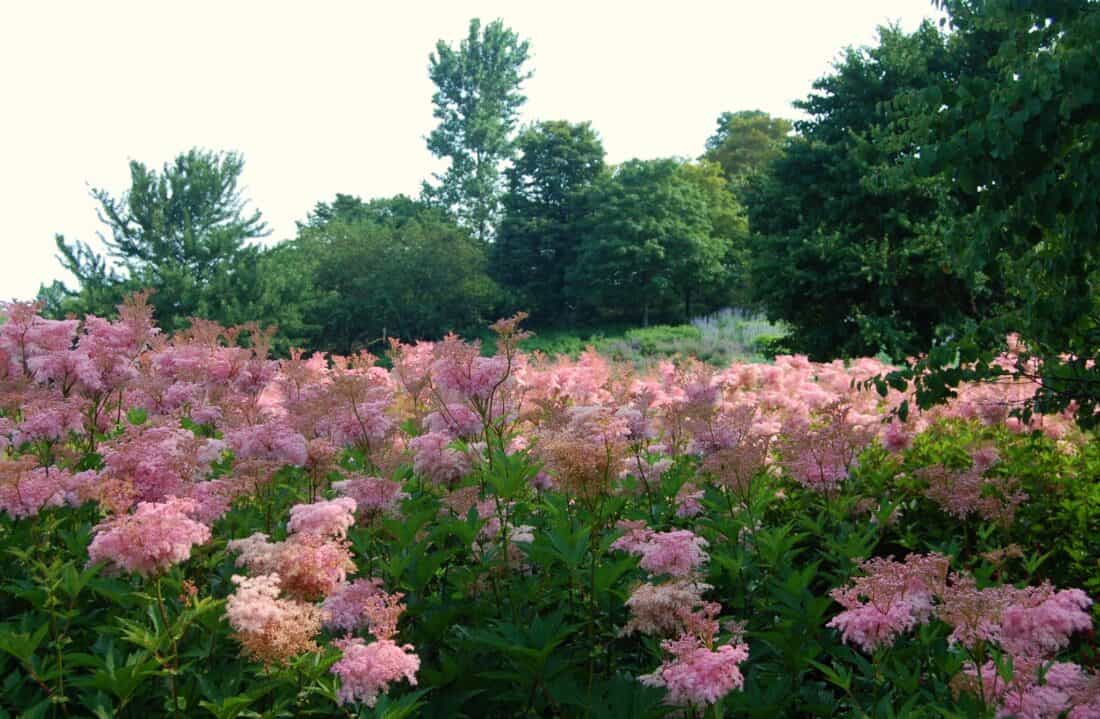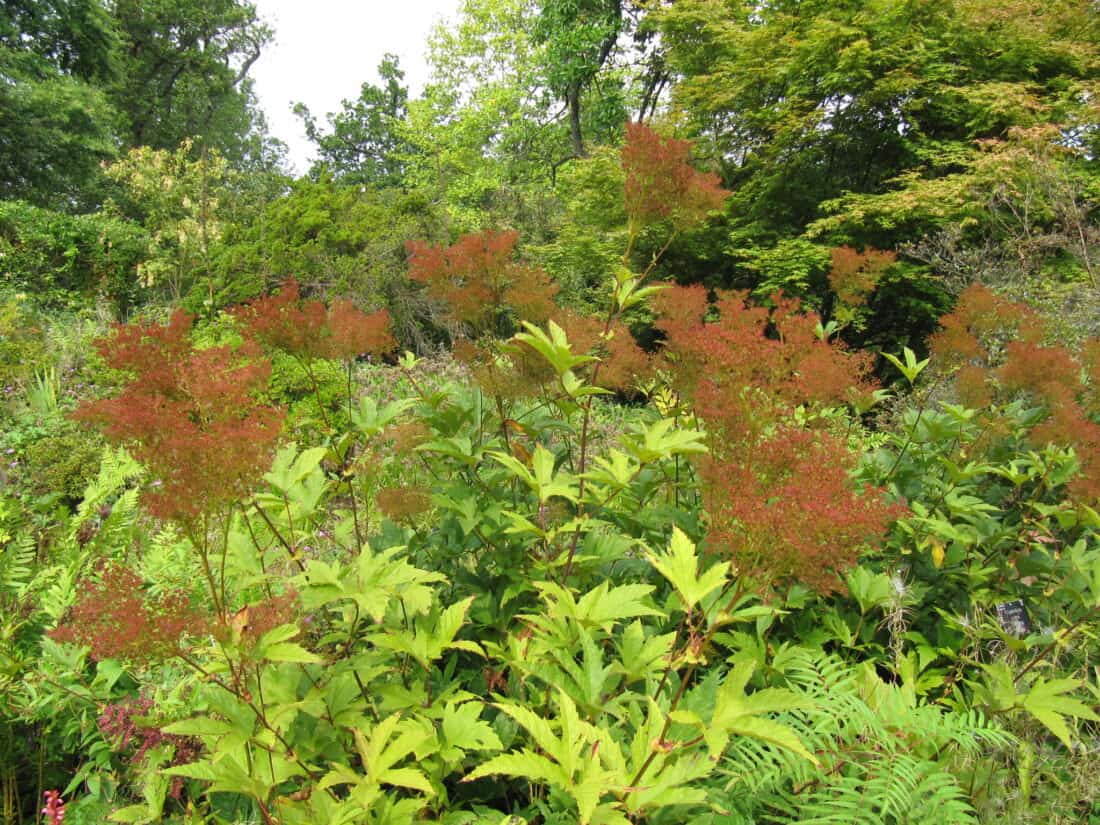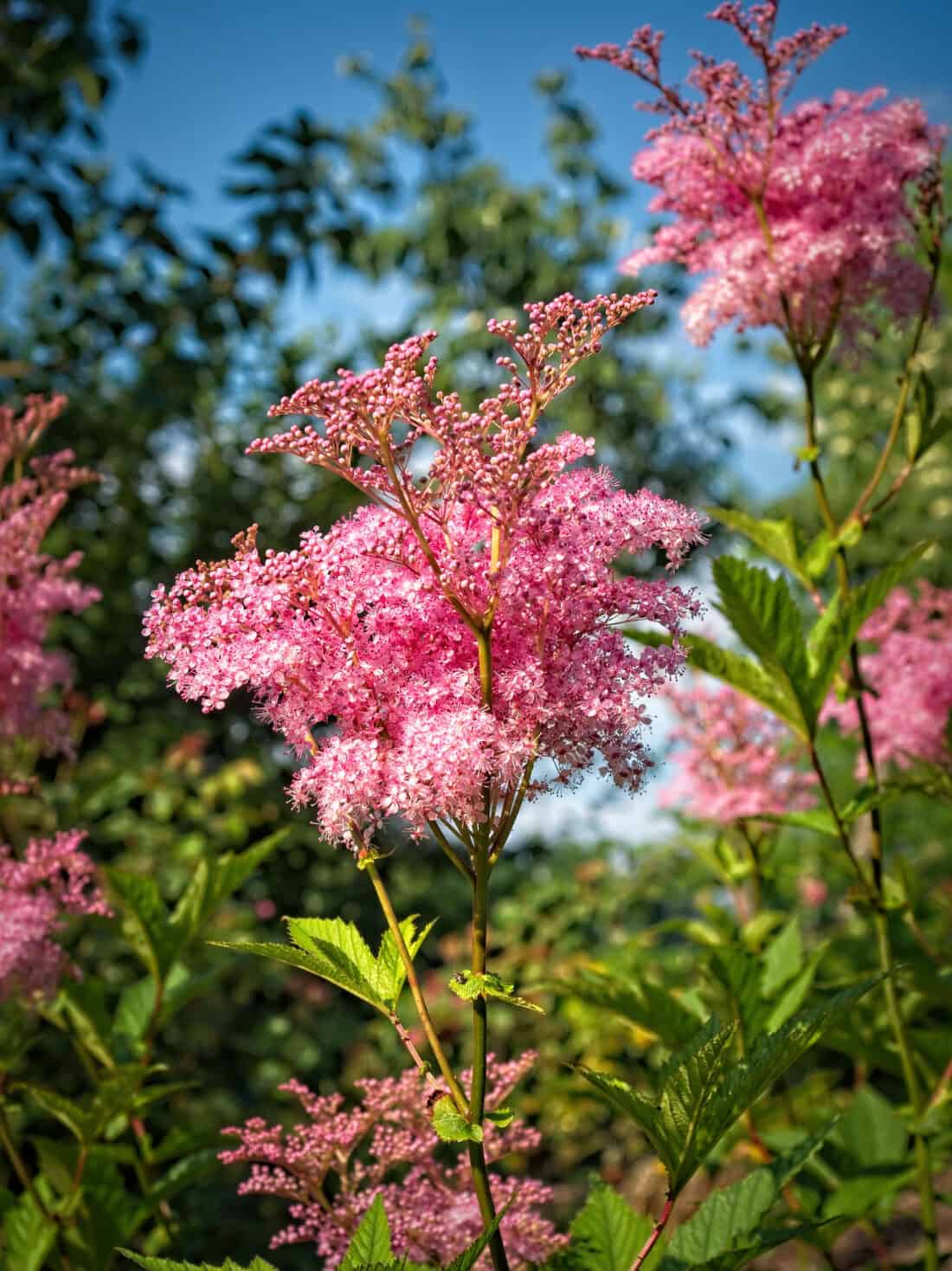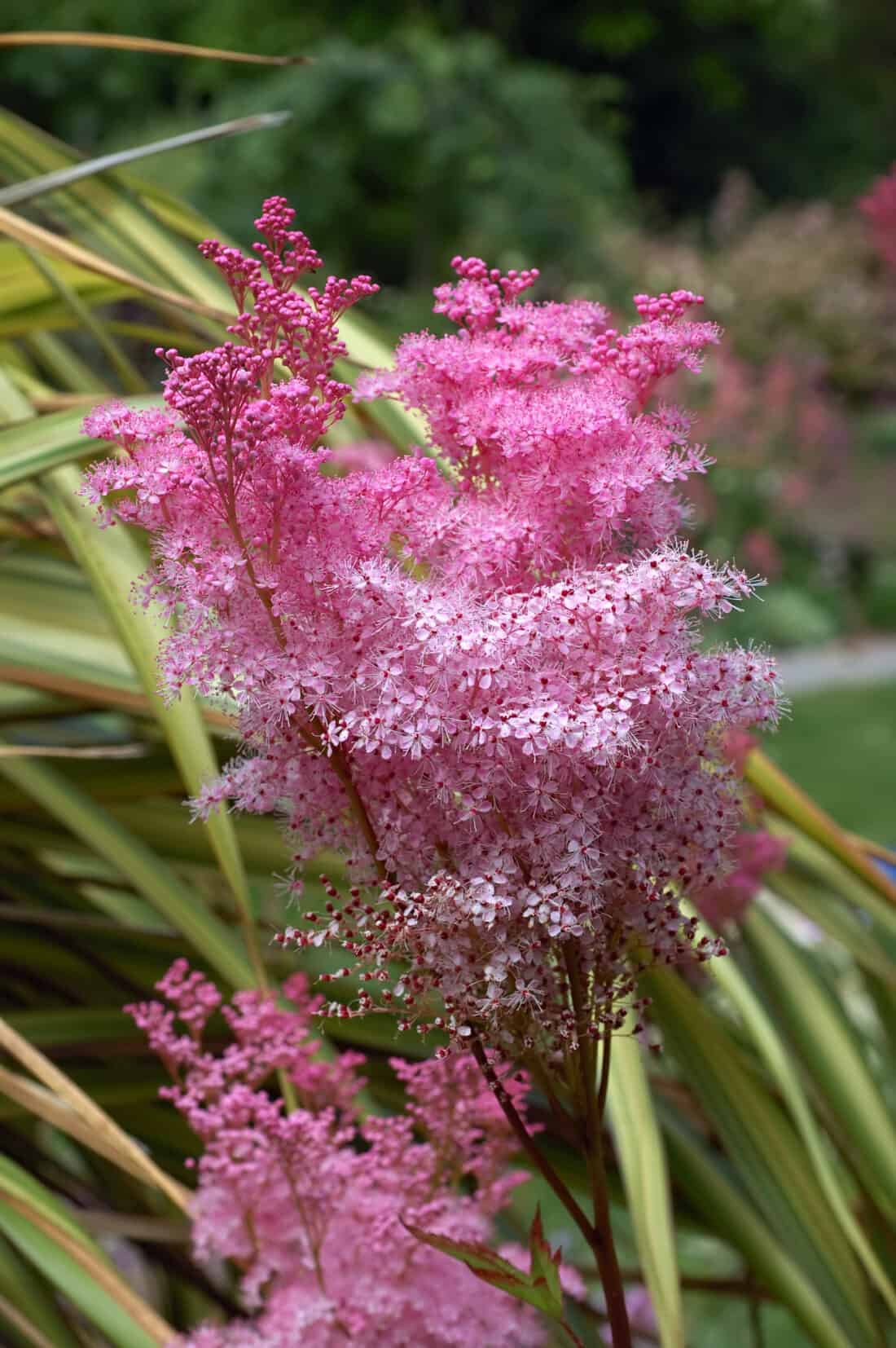Filipendula rubra has a retro vibe; it stands out above others, and it is truly an eye-catching plant. It absolutely earns its Queen-of-the-Prairie name.
Its flowers resemble wind-tossed fluff or foam and are impossible not to notice. At a height of up to 6′, in prairies, the pink flowers rise above the surrounding vegetation and can be seen from a considerable distance. It has a very distinctive appearance, and can’t be confused with any other native plant.

I love knowing the medicinal uses of plants. FIlipendula was used by Native Americans for heart troubles and love potions. It is very similar to aspirin. It has also been used to treat gout, influenza, rheumatism, arthritis, fever, kidney and bladder problems – it is an astringent and can be used as a wash for wounds, and a treatment for rashes.
Filipendula is native to many eastern and prairie states but is increasingly rare and threatened in many places. Protecting wetlands and planting them in your garden will help to maintain and encourage their genetic diversity and ensure they continue to thrive.
Problems with Growing Filipendula
I have found that these plants prefer full sun. Without, their stems will reach, weaken and sometimes flop. These native plants also really need consistently moist soils. If allowed to dry out in the summer, the leaves will crisp and are unlikely to recover until the next season.

Filipendula Rubra is the native perennial for North Americans.
Not all Filipendula are North American Natives. There are four common varieties that you might see at garden centers and each has different characteristics, applications, habit.
- Filipendula rubra (Queen of the Prairie):
- Hardiness: USDA zones 3-8.
- Description: Queen of the Prairie is a majestic perennial with tall, erect stems topped by fluffy clusters of pink flowers in summer. Its deeply lobed foliage adds texture and interest to the garden.
- Native Range: Native to eastern North America, particularly in moist meadows and along stream banks.
- Interesting Details: Queen of the Prairie is a striking addition to cottage gardens and naturalistic landscapes. It attracts pollinators like bees and butterflies with its nectar-rich flowers.
- Filipendula ulmaria (Meadowsweet):
- Hardiness: USDA zones 3-9.
- Description: Meadowsweet features delicate, frothy clusters of creamy white flowers held above fern-like foliage. Its flowers have a sweet fragrance reminiscent of almonds.
- Native Range: Native to Europe and western Asia, where it grows in damp meadows and along watercourses.
- Interesting Details: Meadowsweet has a long history of medicinal use and was revered by the ancient Celts and Druids for its healing properties. It’s also a favorite of pollinators and beneficial insects.
- Filipendula purpurea (Purple Meadowsweet):
- Hardiness: USDA zones 4-8.
- Description: Purple Meadowsweet boasts spires of deep pink to purple flowers that rise above mounds of deeply cut foliage. Its blooms add a pop of color to the garden in midsummer.
- Native Range: Native to central and eastern Europe, where it grows in moist woodlands and damp meadows.
- Interesting Details: Purple Meadowsweet is an excellent choice for rain gardens and other wet areas in the landscape. It’s also deer-resistant and low-maintenance once established.
- Filipendula vulgaris (Dropwort):
- Hardiness: USDA zones 5-9.
- Description: Dropwort features delicate clusters of white or pink flowers held above finely divided foliage. It has a graceful, airy appearance that adds elegance to the garden.
- Native Range: Native to Europe and western Asia, where it grows in dry meadows and grasslands.
- Interesting Details: Dropwort is often used in traditional herbal medicine for its astringent and diuretic properties. It’s also a valuable nectar source for bees and other pollinators.

The Native Varieties of Filipendula
While Filipendula rubra is commonly known as Queen of the Prairie, there are several cultivated varieties available on the market that offer variations in flower color, size, and other characteristics. Here are some Filipendula rubra varieties you may find:
- Filipendula rubra ‘Venusta’:
- This variety is known for its exceptionally large and showy pink flowers, which can reach diameters of up to 2 inches.
- ‘Venusta’ typically grows to a height of 4 to 6 feet and has deeply lobed foliage similar to the species.
- Filipendula Venusta is a sturdy, upright bush with a bold appearance. Stunning towards the back of a moist border and especially nice at the waterside. Good for cutting. Do not let them dry out during the summer.
- Filipendula rubra ‘Loveliness’:
- ‘Loveliness’ is a compact cultivar with slightly smaller pink flowers compared to the species.
- It reaches heights of around 3 to 4 feet and forms dense clumps of foliage, making it suitable for smaller garden spaces.
- Filipendula rubra ‘Kahome’:
- ‘Kahome’ is prized for its deep rose-pink flowers and compact growth habit.
- This variety typically grows to a height of 3 to 4 feet and produces abundant blooms that attract pollinators.
- Filipendula rubra ‘Alba’:
- ‘Alba’ is a white-flowered variety of Filipendula rubra, offering a striking contrast to the more common pink forms.
- It shares the same robust growth habit and large, deeply lobed foliage as the species.
- Filipendula rubra ‘Rosea’:
- ‘Rosea’ features soft, rosy-pink flowers that add a romantic touch to the garden.
- This variety grows to a similar height as the species and has attractive foliage that remains lush throughout the growing season.
These are just a few examples of the cultivated varieties of Filipendula rubra available in the market. Each variety offers its own unique charm and characteristics, allowing gardeners to select the perfect Queen of the Prairie cultivar for their landscape design needs.

Queen of the Prairie Companion plants
Companion planting with Filipendula rubra, or Queen of the Prairie, can enhance the beauty and biodiversity of your garden. Here are some excellent companion plants to consider:
- Astilbe (Astilbe spp.):
- Astilbes offer a similar airy and feathery appearance to the flowers of Filipendula rubra. They come in a variety of colors, including pink, red, white, and purple, providing a beautiful contrast and complement to the pink blooms of Queen of the Prairie.
- Japanese and Siberian Iris (Iris ensata and Iris sibirica):
- Japanese irises thrive in moist, boggy conditions, making them ideal companions for Filipendula rubra, which also prefers moist soil. The bold, upright foliage and elegant blooms of Japanese iris add structure and drama to the garden.
- Siberian irises are another excellent choice for companion planting with Filipendula rubra. Their slender, grass-like foliage and delicate, jewel-toned flowers create a stunning visual contrast against the larger, more robust blooms of Queen of the Prairie.
- Veronicastrum virginicum (Culver’s Root):
- Culver’s Root is a native North American perennial with tall spikes of tiny white or pink flowers that resemble miniature candles. Its vertical growth habit and airy appearance make it an ideal companion for the upright stems and fluffy blooms of Filipendula rubra.
- Monarda (Monarda spp.):
- Monardas, also known as bee balms or bergamots, are prized for their showy clusters of tubular flowers that attract pollinators like bees, butterflies, and hummingbirds. Planting Monarda alongside Filipendula rubra adds vibrant color and wildlife interest to the garden while providing a complementary texture and form.
- Aruncus dioicus (Goat’s Beard):
- Aruncus dioicus is a tall, stately perennial with feathery, creamy-white plumes of flowers that resemble those of Filipendula rubra. Its upright growth habit and airy appearance complement the graceful presence of Queen of the Prairie in the garden.
- Aruncus dioicus also prefers moist, well-drained soil and partial shade, making them well-suited companions for woodland gardens or damp, shady areas.
- Goat’s Beard blooms in late spring to early summer, providing a burst of vertical interest and texture alongside the pink flowers of Queen of the Prairie, which typically bloom in mid to late summer.
- The fern-like foliage of Aruncus dioicus adds a lush, green backdrop to the garden and provides contrast to the bold, lobed leaves of Filipendula rubra.
These companion plants not only enhance the visual appeal of Filipendula rubra but also create a dynamic and harmonious garden ecosystem that attracts beneficial insects and wildlife. When selecting companion plants, consider factors such as soil moisture, sunlight requirements, and bloom times to ensure compatibility and long-lasting beauty in your garden design.
OH! Thanks a million! this makes me feel about 6′ tall with shocking pink hair!
I think this is just perfect…she IS the Queen of the Prairie!
I follow Kiss My Aster on Twitter as well – her tweets are crazy cool.
Just found this series on natives and think it’s a great idea. I of course went back through the archives to find my own state of California! I like the idea of focusing on just a few plants. Interest in natives is growing steadily in California, but is often intimidating for people who don’t know much about them and are not ready to go all out. It helps to be able to just dip your toe in at first.